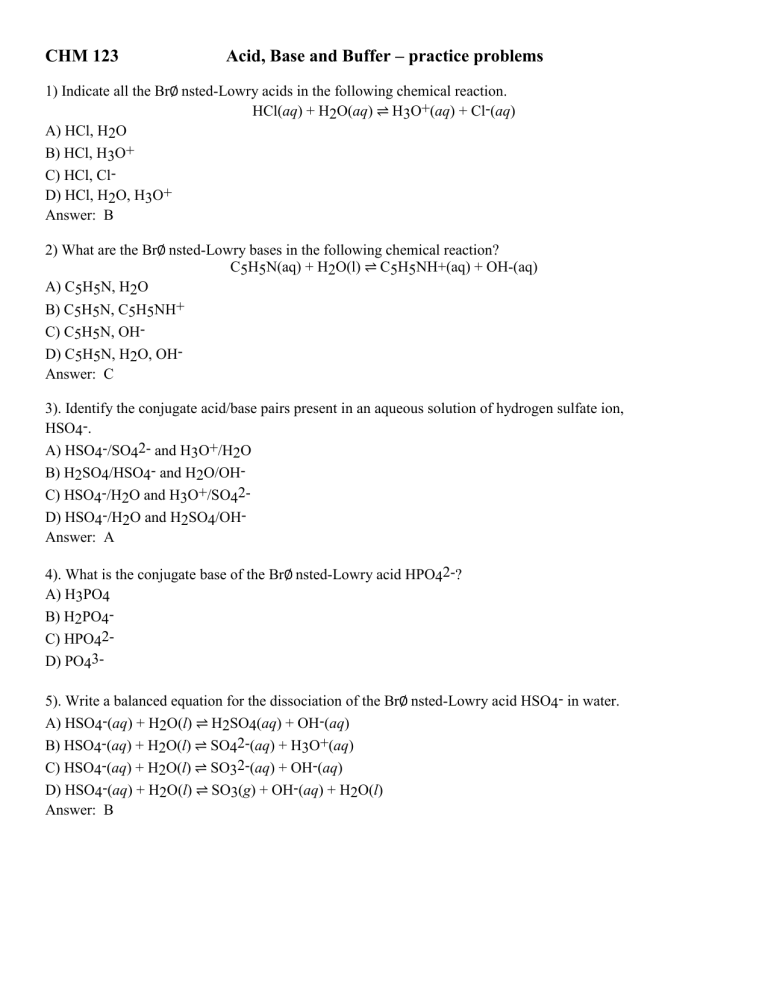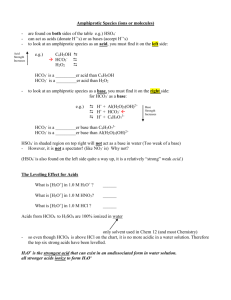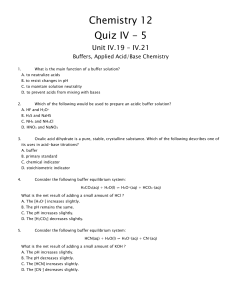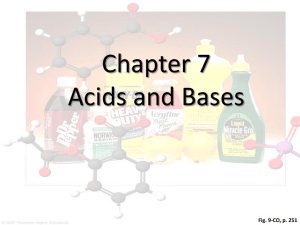Practice problem 2 - acid, base, buffer

CHM 123 Acid, Base and Buffer – practice problems
1) Indicate all the Br ∅ nsted-Lowry acids in the following chemical reaction.
HCl( aq ) + H2O( aq ) ⇌ H3O+( aq ) + Cl-( aq )
A) HCl, H2O
B) HCl, H3O+
C) HCl, Cl-
D) HCl, H2O, H3O+
Answer: B
2) What are the Br ∅ nsted-Lowry bases in the following chemical reaction?
C5H5N(aq) + H2O(l) ⇌ C5H5NH+(aq) + OH-(aq)
A) C5H5N, H2O
B) C5H5N, C5H5NH+
C) C5H5N, OH-
D) C5H5N, H2O, OH-
Answer: C
3). Identify the conjugate acid/base pairs present in an aqueous solution of hydrogen sulfate ion,
HSO4-.
A) HSO4-/SO42- and H3O+/H2O
B) H2SO4/HSO4- and H2O/OH-
C) HSO4-/H2O and H3O+/SO42-
D) HSO4-/H2O and H2SO4/OH-
Answer: A
4). What is the conjugate base of the Br ∅ nsted-Lowry acid HPO42-?
A) H3PO4
B) H2PO4-
C) HPO42-
D) PO43-
5). Write a balanced equation for the dissociation of the Br ∅ nsted-Lowry acid HSO4- in water.
A) HSO4-( aq ) + H2O( l ) ⇌ H2SO4( aq ) + OH-( aq )
B) HSO4-( aq ) + H2O( l ) ⇌ SO42-( aq ) + H3O+( aq )
C) HSO4-( aq ) + H2O( l ) ⇌ SO32-( aq ) + OH-( aq )
D) HSO4-( aq ) + H2O( l ) ⇌ SO3( g ) + OH-( aq ) + H2O( l )
Answer: B
6). Which of the following Br ∅ nsted-Lowry acids does not behave as a strong acid when it is dissolved in water?
A) HBr
B) HCl
C) HNO2
D) HClO4
Answer: C
7).
Which Br ∅ nsted-Lowry acid has the strongest conjugate base?
A) HBr
B) HClO4
C) HF
D) HI
Answer: C
8).
An acidic solution at 25°C has
A) [H3O+] > [OH-] > 1 × 10-7 M.
B) [H3O+] > 1 × 10-7 M > [OH-].
C) [H3O+] = [OH-] > 1 × 10-7 M.
D) [H3O+] < 1 × 10-7 M > [OH-].
Answer: B
Strong Acids /Bases
9). What is the pH of a 0.020 M Ba(OH)2 solution?
A) 1.40
B) 1.70
C) 12.30
D) 12.60
Answer: D
10). What is the pH of a solution prepared by diluting 25.00 mL of 0.10 M HCl with enough water to produce a total volume of 100.00 mL?
A) 1.00
B) 1.60
C) 2.00
D) 3.20
Answer: B
Weak Acids/Bases
11). Determine the acid dissociation constant for a 0.010 M nitrous acid solution that has a pH of 2.70. Nitrous acid is a weak monoprotic acid and the equilibrium equation of interest is
HNO2( aq ) + H2O( l ) ⇌ H3O+( aq ) + NO2-( aq ).
A) 8.0 × 10-3
B) 2.0 × 10-3
C) 5.0 × 10-4
D) 4.0 × 10-4
Answer: C.
12). A tablet containing 500.0 mg of aspirin (acetylsalicylic acid or HC9H7O4) was dissolved in enough water to make 100 mL of solution. Given that K a = 3.0 × 10–4 for aspirin, what is the pH of the solution?
A) 1.57
B) 2.54
C) 3.52
D) 5.08
Answer: B
13) What is the pH of a 0.100 M NH3 solution that has K b = 1.8 × 10-5? The equation for the dissociation of
NH3 is
NH3( aq ) + H2O( l ) ⇌ NH4+( aq ) + OH-( aq ).
A) 1.87
B) 2.87
C) 11.13
D) 12.13
Answer: C
14) Aniline, (C6H5NH2, K b = 4.3 × 10-10 at 25°C) is an industrially important amine used in the making of dyes. Determine the pH of an aniline solution made by dissolving 3.90 g of aniline in enough water to make 100 mL of solution.
A) 4.87
B) 9.13
C) 9.74
D) 10.74
Answer: B
15). Calculate the pH of a 0.100 M NaCH3CO2 solution. K a for acetic acid, CH3CO2H, is
1.8 × 10-5.
A) 2.87
B) 5.13
C) 8.87
D) 11.13
Answer: C
17). Calculate the pH of a 0.100 M CH3NH3Cl solution. K b for methylamine, CH3NH2, is
3.7 × 10-4.
A) 2.22
B) 5.78
C) 8.22
D) 11.78
Answer: B
The Common-Ion Effect
19) What is the hydronium ion concentration in a solution prepared by mixing 50.00 mL of 0.10 M HCN with
50.00 mL of NaCN? Assume that the volumes of the solutions are additive and that K a = 4.9 × 10-10 for HCN.
A) 2.4 × 10-10 M
B) 4.9 × 10-10 M
C) 9.8 × 10-10 M
D) 7.0 × 10-6 M
Answer: C
Buffers and Titration Problems:
1) When equal molar amounts of the following sets of compounds are mixed in water, which will not form a buffer solution?
A) NaH2PO4 with Na2HPO4
B) NH3 with NH4Cl
C) CH3CO2H with NaCH3CO2
D) HNO3 with NaNO3
Answer: D
2) Which of the following combinations of chemicals could be used to make a buffer solution?
A) HCl/NaOH
B) HCl/NH3
C) HCl/H3PO4
D) NaOH/NH3
Answer: B
4) What is the pH of a buffered system made by dissolving 17.42 g of KH2PO4 and 20.41 g of K2HPO4 in water to give a volume of 200.0 mL? The K a2 for dihydrogen phosphate is 6.2 × 10-8 and the equilibrium reaction of interest is
H2PO4-( aq ) + H2O( l ) ⇌ H3O+( aq ) + HPO4-( aq ).
A) 7.03
B) 7.17
C) 7.38
D) 7.58
Answer: B
5). What is the [CH3CO2-]/[CH3CO2H] ratio necessary to make a buffer solution with a pH of 4.44? K a = 1.8
× 10-5 for CH3CO2H.
A) 0.50:1
B) 0.94:1
C) 1.1:1
D) 2.0:1
Answer: A
6). A buffer solution is prepared by dissolving 0.200 mol of NaH2PO4 and 0.100 mol of NaOH in enough water to make 1.00 L of solution. What is the pH of the H2PO4-/HPO42- buffer if the
K a2 = 6.2 × 10-8?
A) 6.91
B) 7.21
C) 7.51
D) 7.71
Answer: B
7). What is the magnitude of the change in pH when 0.005 moles of HCl is added to 0.100 L of a buffer solution that is 0.100 M in CH3CO2H and 0.100 M NaCH3CO2? The K a for acetic acid is1.8 × 10-5.
A) 0.00
B) 0.20
C) 0.47
D) 1.30 Answer: C








